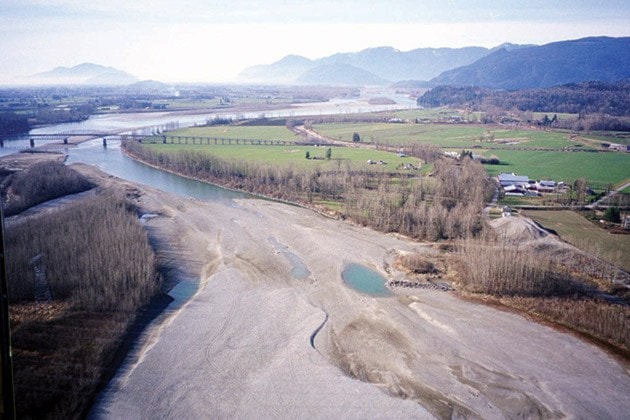Gravel removal by Seabird Island First Nation was approved by both provincial and federal bodies earlier this month.
A Land Act tenure was offered and Water Act approval was issued by the Ministry of Forests, Lands and Natural Resource Operations on Friday, Feb. 6. That will allow the Seabird Island Band to remove 105,000 cubic metres of gravel from the Fraser River, until a cutoff date of March 15.
A provincial ministry official stressed that any impacts to Fraser River habitat from the imminent gravel removal will be both monitored and compensated down the line.
The reaction from members of the Fraser River Gravel Stewardship Committee came swiftly.
"I guess I am shocked. I felt this was one they had good reason to turn down for a number of very legitimate reasons," wrote Otto Langer, member of the Gravel Stewardship Committee.
"The main reasons was that it was habitat and above all was just for commercial gravel mining purposes.
"This is a terrible precedent - it opens up the river for commercial gravel mining. Also where is DFO on this one? We are truly in a new industrial era were near everything goes."
The Progress asked provincial ministry officials if the Seabird approval means there is a new willingness to allow commercial gravel removal when not based on flood control reasons.
"No. Decisions are made on a case-by-case basis," replied Greig Bethel, media relations rep for Ministry of Forests, Lands and Natural Resource Operations.
Regarding critics' allegations that the project will destroy critical fish habitat, Bethel responded that ministry approval is subject to the following conditions:
• Seabird Band must implement an on-site monitoring program to identify and track impacts;
• Salmon populations are not expected to be significantly impacted; however, any impacts to salmon habitat are to be monitored and compensated for.
• A revised design of the excavation area and the establishment of mitigation measures have addressed concerns regarding impacts to sturgeon.
The last time there were small-scale gravel removal projects approved on the Fraser for non-flood protection reason was for "navigation/barge access" to commercial activities along the river, in 2014, according to ministry records.
The Seabird project also obtained the okay from federal Fisheries and Oceans Canada reps, as approvals are under separate pieces of provincial and federal legislation.
DFO reps said the project was carefully considered.
"Following a thorough review, the Department is prepared to issue the Seabird Island Band a Fisheries Act authorization that will include specific conditions designed to protect fish and fish habitat.
"Monitoring of the work is required to ensure compliance with the Fisheries Act and the terms and conditions of the authorization," wrote DFO media rep Carrie Mishima. "The proposed authorized work will avoid sensitive sturgeon and salmon spawning habitats, and includes conditions for mitigation, monitoring and offsetting measures.
Measures to mitigate impacts to fish and fish habitat include "working in specific areas" to avoid sensitive fish habitat and during low water, when the area is isolated and dry. Offsetting measures include "restoring and creating fish habitat."
Part of process saw B.C. government staff and DFO meeting with stakeholders like members of the the Gravel Stewardship Committee to hear their views on the gravel removal application, she noted.
"It is certainly very disappointing that the agencies would compromise one of the last-two known white sturgeon spawning areas in the lower Fraser River," said Marvin Rosenau, in reaction to the recent approvals.
An appeal for an expedited stay and rescinding of the approval was sent this week to the Environmental Appeal Board, he said.
Rosenau had several questions about the sturgeon monitoring process, wondering if the proponent was to do the work, the province, or whether the work is tied to the mine or not.
"I am assuming that whoever wrote this is expecting that the area in and about the mine is to be assessed for sturgeon after the mine has extracted its aggregate.
"In other words, the assessment is to take place after the putative impacts to the white sturgeon have occurred.
"While there have been some cursory assessment of the locations in and about the mine, the pre-mining-understanding of white sturgeon rearing and spawning at the extraction location, and perimeter is pretty limited," Rosenau wrote in a statement. "Except that we know that there are a lot of mature sturgeon here in the spawning season and that eggs/embryos/larvae have been found here.
"What these guys are doing here even if it works, with this so-called assessment, is shutting the barn door after the horses have escaped. Or maybe, given the seriousness of the issue, a better analogy would be, like, beating your grandmother over the head with a baseball bat and then putting an ER vital-signs monitor on her to see if she is still alive.
"That is how grotesque this project, its 'monitoring program' and the Section 9 Authorization are. And the real kicker, here, is—if you did show that the Seabird Indian Reserve mining destroyed one of the last two known remaining white sturgeon spawning sites in the lower Fraser River, how would you ever compensate for that? Build a white sturgeon hatchery?" he asked. "This is so vile."
Seabird Chief Clem Seymour called the approval "a step forward" and the struggle to get the necessary approvals "an uphill battle" for the band.
"We have been looking at this for a long time. There was a balance that we let go by not taking care over the years. This is one step toward taking care and restoring the balance of things," he said.
Seabird, which is located between Agassiz and Hope, has lost about 1200 acres to erosion in the river.
"We understand what the salmon and sturgeon need. We also understand how much we've lost because gravel builds up, and the water gets shallow."
jfeinberg@theprogress.com
Twitter.com/chwkjourno
